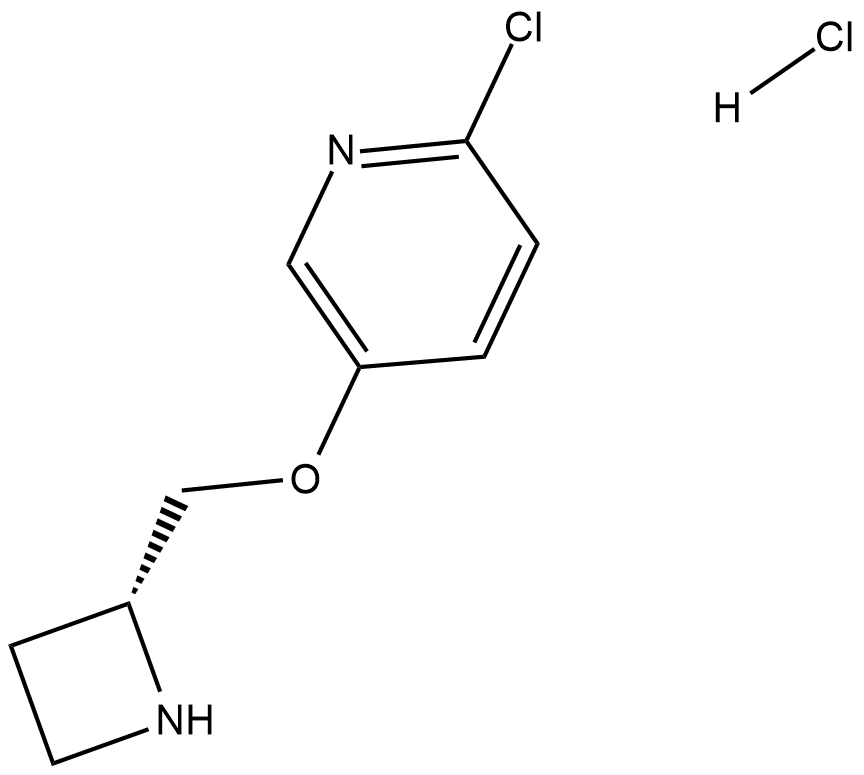Tebanicline hydrochloride (Synonyms: Ebanicline, Tebanicline) |
| Catalog No.GC19351 |
Tebanicline hydrochloride (ABT594 hydrochloride) is a nAChR modulator with potent, orally effective analgesic activity.
Products are for research use only. Not for human use. We do not sell to patients.

Cas No.: 203564-54-9
Sample solution is provided at 25 µL, 10mM.
Tebanicline hydrochloride (ABT594 hydrochloride) is a nAChR modulator with potent, orally effective analgesic activity. It inhibits the binding of cytisine to α4β2 neuronal nAChRs with a Ki of 37 pM.
Tebanicline is a novel, potent cholinergic nAChR ligand with analgesic properties that shows preferential selectivity for neuronal nAChRs. It inhibits the binding of cytisine to α4β2 neuronal nAChRs with a Ki of 37 pM. Functionally, tebanicline is an agonist. At the transfected human α4β2 neuronal nAChR in K177 cells, with increased 86Rb+ efflux as a measure of cation efflux, ABT-594 has an EC50 value of 140 nM with an intrinsic activitycompared with (-)-nicotine of 130%; at the nAChR subtype expressed in IMR-32 cells, an EC50 of 340 nM; at the F11 dorsal root ganglion cell line, an EC50 of 1220 nM; and via direct measurement of ion currents, an EC50 value of 56,000 nM at the human α7 homo-oligimeric nAChR produced in oocytes[1]
Tebanicline is a potent antinociceptive agent with full efficacy in models of acute and persistent pain and that these effects are mediated predominately by an action at central neuronal nAChRs[2]. Tebanicline produces significant antinociceptive effects in mice against both acute noxious thermal stimulation. ABT-594 is orally active, but 10-fold less potent by this route than after i.p. administration. The antinociceptive effect of ABT-594 is prevented, but not reversed, by the noncompetitive neuronal nicotinic acetylcholine receptor antagonist[3]. Tebanicline has antinociceptive effects in rat models of acute thermal, persistent chemical, and neuropathic pain. Direct injection of tebanicline into the nucleus raphe magnus (NRM) is antinociceptive in a thermal threshold test and destruction of serotonergic neurons in the NRM attenuates the effect of systemic tebanicline[4].
References:
[1]. Donnelly-Roberts DL, et al. ABT-594 [(R)-5-(2-azetidinylmethoxy)-2-chloropyridine]: a novel, orally effective analgesic acting via neuronal nicotinic acetylcholine receptors: I. In vitro characterization.J Pharmacol Exp Ther. 1998 May;285(2):777-86.
[2]. Bannon AW, et al. ABT-594 [(R)-5-(2-azetidinylmethoxy)-2-chloropyridine]: a novel, orally effective antinociceptive agent acting via neuronal nicotinic acetylcholine receptors: II. In vivo characterization. J Pharmacol Exp Ther. 1998 May;285(2):787-94.
[3]. Decker MW, et al. Antinociceptive effects of the novel neuronal nicotinic acetylcholine receptor agonist, ABT-594, in mice. Eur J Pharmacol. 1998 Apr 3;346(1):23-33.
[4]. Decker MW, et al. The role of neuronal nicotinic acetylcholine receptors in antinociception: effects of ABT-594. J Physiol Paris. 1998 Jun-Aug;92(3-4):221-4.
Average Rating: 5 (Based on Reviews and 17 reference(s) in Google Scholar.)
GLPBIO products are for RESEARCH USE ONLY. Please make sure your review or question is research based.
Required fields are marked with *




















